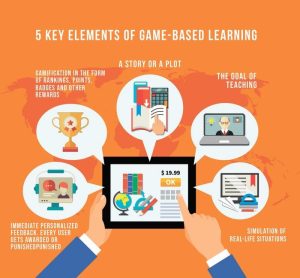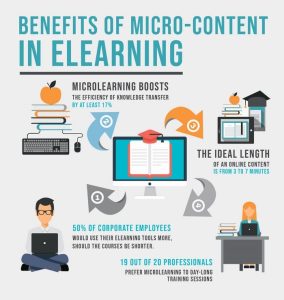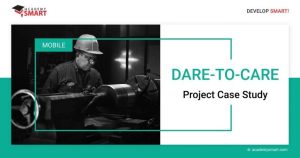8 types and formats of eLearning content
Introduction
Retention rates are the bottleneck of learning, as it does not matter how good the lector is in teaching if the students cannot remember what was said. Not because they are lazy or stupid — they just cannot do it, psychologically and physiologically. According to the data from the Research Institute of America published in Forbes, e-Learning formats enables 25% to 60% retention rates, which is 3 to 6 times more than traditional learning with 8% to 10%. The reason is simple — with elearning, the students can advance at their own pace and revisit the material they need using special virtual educational tools, commonly known as learning management systems. This is the reason for eLearning becoming the backbone of corporate education.
As any other eLearning professional, your goal is to deliver the training content your learners will enjoy. But where to start? What type of eLearning content is the best for your target audience? What is eLearning format is feasible to create within the given time and budget? Today we explore eLearning content formats and try to give answers to the questions above.
There are 5 key factors that influence the choice of eLearning content format:
- Team size at your disposal
- The volume of content you need to create
- The subject you explain and the ideal mode of delivering the content on it
- The average audience’s understanding
- The business objectives you need to achieve
3 types of elearning content
What is eLearning content types? There are three main types:
- Point-of-need support. This kind of eLearning tools and resources provides the learner with a piece of information required to perform a task quickly.
- Learning experience. This content-type is intended for the long-term building of skills and behaviors. Unlike short-term help from the point-of-need support, learning experience content transforms the learner’s behavior over prolonged periods.
- Information. Somewhat in between the previous two types, informational content helps increase learner’s performance when there is a context for applying it. For example, product onboarding content for new employees, etc.
8 key eLearning content formats
It’s time to look at 8 key eLearning content formats, explore the goals they serve and choose the best format for your online courses.
1. Computer-Based Training (CBT)/Web-Based Training (WBT)
Computer-Based Training (CBT) or Web-Based Training (WBT) refers to eLearning delivered over the personal or networked computer or mobile device. The computer-based training courses can be web-based or local, synchronous (when new materials are made available to the whole group according to schedule), or asynchronous (when learners advance at their own pace). CBT content for elearning is usually provided through the means of computer-based training software like a Learning Management System (LMS).
Research shows that eLearning can speed up the training time by 40%-60% as compared to traditional learning. This means your employees can spend less time training before their performance grows and improves your company’s bottom line.
The greatest advantages of computer-based training for eLearners are the ability to train at their own pace (95%) and no need to commute (84%). Computer-based training methods like distance learning through mobile devices satisfy these requests in full.
The biggest downside of computer-based training is its high cost of implementation and producing content for it. This is why this approach is best used by large organizations for long-term corporate education, like computer-based safety training for new employees.
2. Game-Based Learning/Gamification/Serious Games
3.20 billion — such as the evaluation of the global serious games market back in 2017. It is expected to grow 4 times, to nearly $9.200 billion by 2023, exhibiting a CAGR of 19.2% for 6 years.
Gamification is one of the basic features of edutainment, providing learners with incentives to progress in forms of badges, scoreboards, and certificates for achievements. While it is very helpful to keep the learners engaged, there are much more serious benefits of creating game-based elearning content for business. Custom-developed serious games provide feature-rich graphics and complex gameplay with rewards for the learner achieved by scoring points and completing tasks.
Game-based learning in education can be defined as productive video games designed to improve the skills of their users, motivate them intrinsically, and recreate situations they are likely to face in real life.
Despite varying hugely in formats and goals, most game-based learning samples include 5 key elements:
- A story or a plot
- Gamification in the form of rankings, points, badges and other rewards
- Immediate personalized feedback. Every user gets awarded or punished for making every choice and receives an explanation of why it was done so. This way, they can analyze their mistakes and do better next time.
- Simulation of real-life situations
- The goal, as every serious game has a purpose to teach learners something.

Serious games are so popular due to improving learner’s motivation and engagement, enabling practice without risks, and improving the retention of knowledge.
Game-based learning is mostly used for training soft skills, conflict solving, security management, as well as training for complex manufacturing processes or nursing.
3. Micro-сontent
Micro-content is things like checklists, short quizzes, infographics, flashcards, labeled diagrams, short videos, or slideshows that depict a single concept only. This type of elearning content can be revisited as many times as needed to ensure good retention of concepts through learning in brief nuggets.
Benefits of micro-content in eLearning:
- The Journal of Applied Psychology states that microlearning boosts the efficiency of knowledge transfer by at least 17%
- A survey among L&D professionals uncovered that 19 out of 20 prefer microlearning to day-long training sessions — because their learners prefer it.
- A report from Software Advice showed that 50% of corporate employees would use their eLearning tools more, should the courses be shorter.
- 3-7 minutes long information nuggets match the optimal attention span and working memory capacity of average people
- Modular microlearning content is easier to create and update

How to make microlearning content work?
- Focus on one idea or concept at a time. Make sure the content can be consumed in under 7 minutes and require little effort from the learner to comprehend.
- Provide tests and quizzes to quickly assess the knowledge retention rate and see if the learners indeed learn anything from your micro-courses.
- Responsive design, as micro-content is usually consumed from mobile devices
- Offline mode availability to provide the knowledge whenever needed
- Use gamification features to keep learners entertained
- Constantly analyze your course statistics and fine-tune the content.
- Don’t devote any time to theory and general principles. Micro-content is about delivering “how-to” from the get-go, as your learners need ready solutions.
Micro-content cannot be used if the topic you teach is complex and requires a strong understanding of the theoretical background. In this case, you should select other eLearning content formats.
4. Mobile content
M-learning consumed in bite-sized chunks helps learners access your course content through mobile devices anytime and anywhere. Mobile applications for learning help keep the learners focused and convey the training efficiently. It also helps prevent cognitive overload, so the learners bite as much as they can chew.
Top-3 areas of use for mobile learning corporate training are onboarding, compliance training, and technical skills.
Below are just some of the reasons to create elearning content for a mobile learning environment:
- M-learning market grows for 23% YoY, making it one of the fastest-growing e-Learning domains
- Businesses adopt M-learning as it provides much better learning experiences for their employees, making the implementation of mobile learning apps one of the top three training priorities.
- According to a mobile learning case study from Merrill Lynch, m-learners complete the courses 45% faster, ensuring more time to perform their normal jobs.
With a proper LMS, developing and managing M-learning content becomes easy. Your organization can make videos, tests, exercises, eBooks and other eLearning materials accessible anytime and anywhere and level up the efficiency of your corporate training.
5. Simulations and Simulation Games
Business simulation games are eLearning tools that provide structured learning based on real-life scenarios. These are great for practicing marketing, managerial accounting, operations, etc. Playing business management simulation games online helps employees see how their decisions influence business numbers and affect the bottom line directly. This is a great way of improving the decision-making capabilities of a managerial suite.
6. Augmented Reality/Mixed Reality/Virtual Reality
Virtual, augmented and mixed realities in education are a new and great way to deliver valuable knowledge based on real-life experience. From virtual chemical labs that do not need chemical consumables to virtual training for oil rig crews performed on the shore, AR and VR content for elearning offer a new approach to replicating real-life situations and practicing the best response scenarios.
A recent report from Digi-Capital states there are above 60 million installed base AR/VR applications with a total cost of around $10-15 billion. These numbers are projected to reach 3,5 billion installed apps worth $85-90 billion till 2025
Virtual, augmented and mixed reality simulations are a great way to safely train vital skills for people who risk their lives and health at work. It has a plethora of applications, from healthcare and manufacturing to education and real estate. Possible AR/VR use cases for business include:
- Product demos
- Employee training
- Try before you buy services
- Brand interaction increase
- Explanation of complex concepts
7. Videos/Learning Videos
People prefer videos to texts, as these provide educational information with emotional coloring they can relate to. This helps convey business-critical information faster and more cost-efficiently. Every organization should be using learning videos in its L&D programs to make them versatile and accessible for all users.
We list 7 best learning formats for video training you can use as a part of your L&D courses:
- Talking head videos that share expertise
- Animated videos to increase retention rates
- Demo videos depicting some work process
- Simulations for a real-life training experience
- Screencasts for explaining the software
- Interactive videos to increase engagement
- Summary videos for quick summing up
Interactive videos with hot spots and quizzes help keep learners’ attention focused. This helps avoid learner passivity that can be detrimental for prolonged video viewing. When users can click, drag, hover, scroll, gesture, and perform other digital actions, their retention rates grow.
8. Webinars
Webinars became increasingly popular since the beginning of COVID-19 pandemic and the lockdowns it resulted in. This is a great way to present information over the web to nearly unlimited numbers of participants.
A webinar is usually a live or pre-recorded way of elearning content creation. While live webinars provide a chance to ask the presenter a question in real-time, pre-recorded ones can be viewed at the learner’s most convenient time. Interactive webinars for collaborative learning help learners dive deep into the topic faster and get their questions answered in real-time.
What training is best conveyed through distance learning webinars?
- Narrow topics like industry updates
- Topics that are best discussed live (Q&A sessions where input from viewers is crucial to present a topic)
- Demos on doing something through screen sharing
Benefits of webinars for learning:
- Distance learning webinars help deliver mission-critical information to learners at masse nearly without any budget expenses.
- Pre-recorded webinars allow training new and new groups of learners without the need for a live presenter to meet them (and associated commuting expenses)
- For some content, webinars are the most user-friendly form of training delivery.
Webinars can be a part of any eLearning course or can be provided as standalone tools. They are even more effective as a primary tool of a comprehensive LMS in combination with other modern educational technologies, which we reviewed above. What are the typical expenses for developing a universal enterprise learning management system, read also our blog – How Much Does It Cost to Develop an LMS.
Conclusions
As you can see, there are multiple eLearning content formats suited for various purposes. Most of them can be combined within an LMS, but there are rarely any eLearning platforms that might fit all your business goals. The best way to ensure your LMS supports all the eLearning content formats you require is to order a custom LMS development and receive a tool uniquely suited to your business needs. Academy Smart developers have rich experience in creating custom learning management systems. They will be glad to offer it to you for creating e-learning software from scratch or upgrading existing LMS of any level of complexity.
To get know main benefits of the Learning management system, watch this video.
eLearning content: Frequently Asked Questions
How many types of eLearning content are there?
There are eight main types:
- computer-based or web-based training;
- game-based learning;
- micro-сontent;
- mobile content;
- simulations and simulation games;
- augmented, mixed or virtual reality;
- learning videos;
- webinars.
What content format is most effective for learning online?
The most effective way is to combine different types of learning content within a single LMS. If the LMS needs more modern features, you can always order the services of developers-outstaffers who will update the capabilities of your training software.



